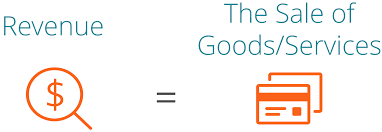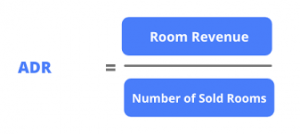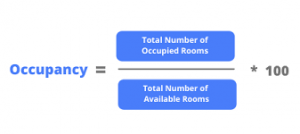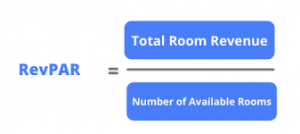Revenue Formulas
To boost your hotel performance

Hotel Revenue formulas are thought to be too complicated. As a result, hoteliers try to avoid the issue by simply hiring a specialist to deal with it. We do not intend for you to become a Revenue Manager expert if that is not what you want.
However, we do suggest that you understand and analyze your hotel revenue yourself rather than completely delegating the future of your business to a third party. Although having a Revenue Management consultant is a must in many hotel businesses, being able to understand the information provided by the metrics and the strategies taken upon them, will allow you to have greater control of your business and, therefore, guarantee its growth.
In this post we will show you how to calculate some of the most useful rooms revenue formulas to optimize the revenue growth of your business.
Understanding Revenue Management
According to wikipedia definition, Revenue Management is the analytical discipline that combines data-driven tactics with pricing strategies to optimize revenue growth by aligning pricing and availability with each customer segment.
That is to say that Revenue Management in hospitality industry means not selling a particular room today at a low price in order to sell that room tomorrow at a higher price or selling at a low price today if no higher demand is expected in the coming days.
By relying on data and statistics, and analyzing them carefully, Revenue Managers can accurately predict demand and consumer behaviors, which will ultimately allow them to make more sensible pricing decisions in order to maximize revenue and profit for the hotel.
Data Analytics
Data analytics is the methodical collection, sorting and processing of business data to gain new insights, and enables an ever-expanding field of knowledge and practices that drive performance.
In other words, analytics can describe the details of past performance, explain why the hotel performed as it did, what future performance can be expected, and finally, what management can do to better influence performance in the future.
Systematically leveraging data provides a consistent view of the company’s performance timeline, while enabling management to make changes to increase performance and reduce future risks.
If you would like to to get a full report with sensible data about your hotel market`s performance, click HERE
Revenue Management Formulas
A key performance indicator (KPI) is a value that reflects how your business is doing in relation to established objectives. A KPI is measurable and therefore, through data and formulas, guides managers to understand how the business is performing and what needs to be adjusted to achieve a hotel revenue optimization.
Your Data Analysis
Although they look quite similar, there is a difference between adr and revpar KPI. While both indicate the revenue per room, ADR will calculate the average revenue per room based on rooms sold or, in other words, based on occupancy; while RevPAR will indicate the amount of revenue earned based on all rooms available in the hotel, regardless of occupancy.
This data will be particularly useful to measure, for example, if the costs of each room are being covered and if the profit margin per room is as expected. Let’s not forget that regardless of occupancy, there are fixed costs associated to rooms that must be covered on a monthly basis.
Let´s see the hotel revenue formulas with an example.
Imagine our hotel has 60 available rooms. We will analyse the performance of one particular date in July 2021 by using some of the KPI. Our total room revenue was $4500 and the number of rooms occupied was 40.
Average Daily Room Rate Formula (ADR)
This measures the amount of revenue collected daily for all your occupied rooms.
To calculate adr, divide the revenue earned from rooms by the rooms sold or occupied.
ADR = revenue earned from rooms/rooms sold or occupied
ADR = $4500/40
ADR = $112.5

Hotel Occupancy Rate Formula (OCC):
This measures your hotel’s daily occupancy.
The formula for occupancy percentage results when dividing occupied rooms by the total number of rooms available and multiply by 100
OCC = occupied rooms/total rooms available *100
OCC = 40/60*100 = 66.6%
OCC = 66.6%

Revenue Per Available Room Formula (RevPAR)
Revpar means the revenue generated per available room.
There are two ways to calculate revpar, you can either divide the total revenue earned by the total available rooms or multiply your ADR by your occupancy rate and divide it by 100.
Revpar calculation example:
RevPar = total room revenue earned/total rooms available
RevPar = $4500 / 60
RevPar = $75
or
RevPa r = ADR*OCC/100
RevPar = $112.5 * 66.6% / 100
RevPar = $75

The Market Analysis
Analyzing the above metrics in isolation will not give us enough information to know if our hotel revenue is doing good.
Therefore, it is important to use other formulas that will help us to compare ourselves with respect to what is happening in the market, that is to analyze how our business is behaving with respect to our competitors.
For example, if our average occupancy was 66.6% when we usually have 75% but after analyzing our competitive set we noticed that the average was 60%, this data shows us that our business outperformed the competition. If we did not reach our average occupancy it could have been due to external factors such as travel restrictions, a pandemic, political/social issues in our region, etc.
If you wish to learn some hotel revenue management strategies for post pandemic, we invite you to visit our previous post Revenue Management Strategies Post-Pandemic
Revenue generating Index (RGI)
The revpar penetration calculation measures the performance of your RevPAR relative to a grouping of other hotels or competitive set.
To calculate it, divide your RevPAR by the aggregated group of hotels’ RevPAR and multiply it by 100
Note: An RGI greater than 100 represents more than the expected market share, and less than 100 represents you are not getting as much of the share as you should.
RGI = your hotel RevPAR / your competitive set RevPAR *100
RGI = $125/$115*100
RGI = $108

Market penetration index (MPI)
This measures your hotel performance with respect to your competitors in terms of occupancy.
To calculate it, divide your hotel occupancy rate by your market occupancy rate and multiply it by 100
Note: In the same way as the RGI, if you score less than 100, it means your performance is under the market average. However, if your score is more than 100, it shows that you’re performing better than your competitors.
MPI = your OCC%/ your market OCC%*100
MPI = 66.6% / 60%*100
MPI = 111
If you would like to get a Revenue Management consultant to help you analyse your property performance, click on the link below.
